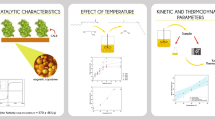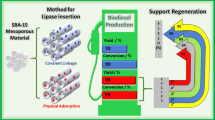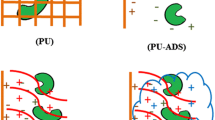Abstract
This study aims to combine distinctive supports with a feasible, easy and cleaning method to lipase immobilization. Commercial lipase from Burkholderia cepacia is physically adsorbed using polymeric powders such as polyhydroxybutyrate (PHB), polyhydroxybutyrate-co-hydroxyvalerate (PHBV) and copolymer styrene-divinylbenzene (St-DVB). It is found that the immobilization on PHB has a high amount of the lipase per support mass (1065 U g−1). The activation energy also shows a value higher than the lipase immobilized onto both PHBV (348 U g−1) and St-DVB (355 U g−1). FTIR, TG, DSC and XRD techniques are used to polymer powders and immobilized lipase characterization. Morphological arrays, loss masses, enthalpy values and crystallinity degrees are evaluated. In order to analyze the morphological aspects of the raw polymers after alcohol treatment (before immobilization) and the immobilized lipase, the optical microscopy analysis is used. The immobilized Burkholderia cepacia lipase provides distinctive behavior in the polymer powders.








Similar content being viewed by others
References
Macario A, Verri F, Diaz U, Corma A, Giordano G. Pure silica nanoparticles for liposome/lipase system encapsulation: application in biodiesel production. Catal Today. 2013. https://doi.org/10.1016/j.cattod.2012.07.014.
Guo J, Sun S, Liu J. Conversion of waste frying palm oil into biodiesel using free lipase A from Candida antarctica as a novel catalyst. Fuel. 2020. https://doi.org/10.1016/j.fuel.2020.117323.
Padilha GS, Campos VAB, Costa MC, Franco TT. Multi-walled carbon nanotubes used as support for lipase from Burkholderia cepacia. J Therm Anal Calorim. 2018. https://doi.org/10.1007/s10973-018-7467-5.
Nady D, Zaki AH, Raslan M, Hozayen W. Enhancement ofmicrobial lipase activity via immobilization over sodium titanate nanotubes for fatty acid methyl esters production. Int J Biol Macromol. 2020. https://doi.org/10.1016/j.ijbiomac.2019.09.240.
Mijone PD, Bôas RNV, Bento HBS, Reis CER, Castro HF. Coating and incorporation of iron oxides into a magnetic-polymer composite to be used as lipase support for ester syntheses. Renew Energy. 2020. https://doi.org/10.1016/j.renene.2019.10.100.
Souza RL, Faria ELP, Figueiredo RT, Fricks AT, Zanin GM, Santos OAA, Lima AS, Soares CMF. Use of polyethylene glycol in the process of sol–gel encapsulation of Burkholderia cepacia lipase. J Therm Anal Calorim. 2014. https://doi.org/10.1007/s10973-014-3663-0.
Mesa M, Pereañez JA, Preciado LM, Bernal C. How the Triton X-100 modulates the activity/stability of the Thermomyces lanuginose lipase: insights from experimental and molecular docking approaches. Int J Biol Macromol. 2018. https://doi.org/10.1016/j.ijbiomac.2018.09.009.
Rios NS, Pinheiro BB, Pinheiro MP, Bezerra RM, Santos JCS, Gonçalves LRB. Biotechnological potential of lipases from Pseudomonas: sources, properties and applications. Process Biochem. 2018. https://doi.org/10.1016/j.procbio.2018.09.003.
Moreira WC, Elias ALP, Osório WR, Padilha GS. Alternative method to improve the ethyl valerate yield using an immobilised Burkholderia cepacia lipase. J Microencapsul. 2019. https://doi.org/10.1080/02652048.2019.1626927.
Bilal M, Iqbal HMN. Naturally-derived biopolymers: potential platforms for enzyme immobilization. Int J Biol Macromol. 2019. https://doi.org/10.1016/j.ijbiomac.2019.02.152.
Foresti ML, Ferreira ML. Ethanol pretreatment effect and particle diameter issues on the adsorption of Candida rugosa lipase onto polypropylene powder. Appl Surf Sci. 2004. https://doi.org/10.1016/j.apsusc.2004.05.195.
Barbe S, Lafaquière V, Guieysse D, Monsan P, Remaud-Siméon M, André I. Insights into lid movements of Burkholderia cepacia lipase inferred from molecular dynamics simulations. Proteins. 2009. https://doi.org/10.1002/prot.22462.
Carvalho NB, Barbosa JMP, Oliveira MVS, Fricks AT, Lima AS, Soares CMF. Biochemical properties of Bacillus sp. ITP-001 lipase immobilized with a sol gel process. Quim Nova. 2013. https://doi.org/10.1590/S0100-40422013000100010.
Padilha GS, Tambourgi EB, Alegre RM. Evaluation of lipase from Burkholderia cepacia immobilized in alginate beads and application in the synthesis of banana flavor (isoamyl acetate). Chem Eng Commun. 2018. https://doi.org/10.1080/00986445.2017.1370707.
Alves MD, Aracri FM, Cren EC, Mendes AA. Isotherm, kinetic, mechanism and thermodynamic studies of adsorption of a microbial lipase on a mesoporous and hydrophobic resin. Chem Eng J. 2017. https://doi.org/10.1016/j.cej.2016.11.069.
Bento HBS, Castro HF, Oliveira PC, Freitas L. Magnetized poly(STY-co-DVB) as a matrix for immobilizing microbial lipase to be used in biotransformation. J Magn Magn Mater. 2017. https://doi.org/10.1016/j.jmmm.2016.11.061.
Rodrigues RC, Virgen-Ortíz JJ, Santos JCS, Berenguer-Murcia A, Alcantara AR, Barbosa O, Ortiz C, Fernandez-Lafuente R. Immobilization of lipases on hydrophobic supports: immobilization mechanism, advantages, problems, and solutions. Biotechnol Adv. 2019. https://doi.org/10.1016/j.biotechadv.2019.04.003.
Heitmann AP, Patrício PSO, Coura IR, Pedroso EF, Souza PP, Mansur HS, Mansur A, Oliveira LCA. Nanostructured niobium oxyhydroxide dispersed Poly(3-hydroxybutyrate) (PHB) films: highly efficient photocatalysts fordegradation methylene blue dye. Appl Catal B-Environ. 2016. https://doi.org/10.1016/j.apcatb.2016.02.031.
Lau SC, Lim HN, Basri M, Masoumi HRF, Tajudin AA, Huang NM, Pandikumar A, Chia CH, Andou Y. Enhanced biocatalytic esterification with lipase-immobilized chitosan/graphene oxide beads. PLoS ONE. 2014. https://doi.org/10.1371/journal.pone.0104695.
Singh S, Mohanty AK. Wood fiber reinforced bacterial bioplastic composites: fabrication and performance evaluation. Compos Sci Technol. 2007. https://doi.org/10.1016/j.compscitech.2006.11.009.
Pandian SRK, Deepak V, Muniyandi J, Rameshkumae N, Gurunathan S. Synthesis of PHB nanoparticles from optimized medium utilizing dairy industrial waste using Brevibacterium casei SRKP2: a green chemistry approach. Colloid Surf B. 2009. https://doi.org/10.1016/j.colsurfb.2009.07.029.
Martins AB, Friedrich JLR, Cavalheiro JC, Garcia-Galan C, Barbosa O, Ayub MAZ, Fernandez-Labuente R, Rodrigues RC. Improved production of butyl butyrate with lipase from Thermomyces lanuginosus immobilized on styrene–divinylbenzene beads. Bioresour Technol. 2013. https://doi.org/10.1016/j.biortech.2013.02.052.
Silva NCA, Miranda JS, Bolina ICA, Silva WC, Hirata DBH, Castro HF, Mendes AA. Immobilization of porcine pancreatic lipase on poly-hydroxybutyrate particles for the production of ethyl esters from macaw palm oils and pineapple flavor. Biochem Eng J. 2014. https://doi.org/10.1016/j.bej.2013.11.015.
Ramos EZ, Miotti Júnior RH, Castro PF, Tardioli PW, Mendes AA, Fernandez-Lafuente R, Hirata DB. Production and immobilization of Geotrichum candidum lipase via physical adsorption on eco-friendly support: characterization of the catalytic properties in hydrolysis and esterification reactions. J Mol Catal B-Enzym. 2015. https://doi.org/10.1016/j.molcatb.2015.05.009.
Cabrera-Padilla RY, Lisboa MC, Pereira MM, Figueiredo RT, Franceschi E, Fricks AT, Lima AS, Silva DP, Soares CMF. Immobilization of Candida rugosa lipase onto an eco-friendly support in the presence of ionic liquid. Bioproc Biosyst Eng. 2015. https://doi.org/10.1007/s00440-014-1322-2.
Vilas Bôas RN, Ceron AA, Bento HBS, Castro HF. Application of an immobilized Rhizopus oryzae lipase to batch and continuous ester synthesis with a mixture of a lauric acid and fusel oil. Biomass Bioenerg. 2018. https://doi.org/10.1016/j.biombioe.2018.09.011.
Martins SRS, Andrade SMS, Fricks AT, Lima AS, Silva DP, Figueiredo RT, Freitas LS, Cabrera-Padilla RY, Soares CMF, Souza RL. Ionic liquid synergistic effect between preparation of hybrid supports and immobilization of lipase applied to esters production. J Therm Anal Calorim. 2020. https://doi.org/10.1007/s10973-020-10408-4.
Persson M, Wehtje E, Adlercreutz P. Immobilisation of lipases by adsorption and deposition: high protein loading gives lower water activity optimum. Biotechnol Lett. 2000;22:1571–5.
Ramezani M, Amoozegar MA, Ventosa A. Screening and comparative assay of poly-hydroxyalkanoates produced by bacteria isolated from the Gavkhooni Wetland in Iran and evaluation of poly-β-hydroxybutyrate production by halotolerant bacterium Oceanimonas sp. GK1. Ann Microbiol. 2015. https://doi.org/10.1007/s13213-014-0887-y.
Li T, Liu H, Zeng L, Yang S, Li Z, Zhang J, Zhou X. Macroporous magnetic poly (styrene–divinylbenzene) nanocomposites prepared via magnetite nanoparticles-stabilized high internal phase emulsions. J Mater Chem. 2011. https://doi.org/10.1019/C1JM10799B.
Pradhan S, Borah AJ, Poddar MK, Dikshit PK, Rohidas L, Moholkar VS. Microbial production, ultrasound-assisted extraction and characterization of biopolymer polyhydroxybutyrate (PHB) from terrestrial (P. hysterophorus) and aquatic (E. crassipes) invasive weeds. Bioresour Technol. 2017. https://doi.org/10.1016/j.biortech.2017.03.11.
Nakagawa H, Tsuge S. Characterization of styrene-divinylbenzene copolymers by high-resolution pyrolysis-gas chromatography. Macromolecules. 1985. https://doi.org/10.1021/ma00152a046.
Shi K, Jing J, Song L, Su T, Wang Z. Enzymatic hydrolysis of polyester: degradation of poly (ε-caprolactone) by Candida antarctica lipase and Fusarium solani cutinase. Int J Biol Macromol. 2020. https://doi.org/10.1016/j.ijbiomac.2019.12.105.
Thiré RMSM, Arruda LC, Barreto LS. Morphology and thermal properties of poly (3-hydroxybutyrate-co-3-hydroxyvalerate)/attapulgite nanocomposites. Mat Res. 2011. https://doi.org/10.1590/S1516-14392011005000046.
Acknowledgements
The authors gratefully acknowledge the financial support provided by FAEPEX/UNICAMP (2021/19) and FAPESP (2016/13352-0).
Author information
Authors and Affiliations
Corresponding author
Ethics declarations
Conflict of interest
The authors declare have no conflict of interest.
Additional information
Publisher's Note
Springer Nature remains neutral with regard to jurisdictional claims in published maps and institutional affiliations.
Supplementary Information
Below is the link to the electronic supplementary material.
Rights and permissions
About this article
Cite this article
Corrêa, W.M., Bortolozo, A.D., Osório, W.R. et al. Physical adsorption used to the immobilization of Burkholderia cepacia lipase into powder polymeric supports. J Therm Anal Calorim 147, 3071–3081 (2022). https://doi.org/10.1007/s10973-021-10714-5
Received:
Accepted:
Published:
Issue Date:
DOI: https://doi.org/10.1007/s10973-021-10714-5




